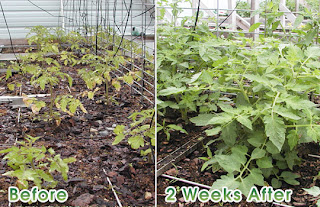New Science Helps Seeds Germinate
Improving seed
germination rate is a straightforward way to improve the efficiency of farming. Seeds that don’t germinate cost as much to
purchase as those that do, so a farmer doesn't get as much for his money
when a needlessly high number of seeds don’t produce anything.
Seeds are simply embryonic plants resting in dormancy surrounded
by stored food inside a seed shell. Germination
begins when the soil temperature is within a suitable temperature range, and the
seed comes in contact with water. As the
seed absorbs the water, the enzymes and food supply stored inside the seed
become hydrated. Once hydrated, the enzymes become active and the seed increases
its metabolic activities to produce energy for the growth process. The growth activity
inside the seed soon creates pressure in the cells as they enlarge causing the
seed coat to split open.
The root (also called the radical) emerges from the seed coat
first, then the shoot expands and emerges shortly thereafter. Root growth slows after the shoot emerges and
begins to grow. The shoot will grow upward and emerge from the soil, where it gains
exposure to sunlight, and photosynthesis begins
to generate energy to accelerate growth.
Planting depth is important because the seed contains only
enough stored food for a short period of growth. The seedling must emerge
from the soil and establish an external food source quickly or it will run out of food and die before the shoot reaches the surface of
the soil.
 |
| Stages of Successful Seed Germination |
A common practice to aid
and accelerate seed germination is to soak the seeds in water immediately before planting. Soaking provides
plenty of water to hydrate the enzymes and food supply inside the seed. Once the plants roots have emerged from the
seed coat they begin to draw nutrients from
the soil and become the main food source.
Obviously, the more nutrients
provided by the roots, the better the seed germination rate will be and the faster the plants will grow. Adding fertilizer to the soil can make more
nutrients available, but too much fertilizer can cause chemical burn to seeds.
So a better way to get the highest germination rate is to ensure that the seeds absorb
as much of the available nutrients as possible, so that only a relatively small
amount of fertilizer is needed.
Plant roots use electromagnetic attraction to draw nutrients from
the soil. BioWash Fertilizer Enhancer is
a product made from plant extracts that has proven to increase electromagnetic attraction (also known as Cation Exchange Capacity or CEC) in plant roots. Adding a mild
solution of BioWash to the soak water will allow the roots to to absorb more of the nutrients available in the soil as soon as the roots emerge from the seed. This improved draw of nutrients will improve
the probability that seed germination will be successful without the need to
increase the amount of fertilizer and risk possible seed burn.
An example of
how BioWash improves germination rate became evident recently to a gardener in
Alabama who has been having problems with low germination rates with spinach seeds for the past 3 years.
On February 8th,
2013 he planted a 2.5’ X 10’ area with seeds that he had soaked for 24
hours in plain water prior to planting.
On March 9 (after 29 days) he saw the first sprouts and subsequently
estimated the germination rate on those seeds to be approximately 75 – 80%.
On February
28th he planted another 2.5’ X 10’ area using seeds from the same
batch as the previous planting. He
repeated his 24 hour soak prior to planting, however, this time he added a
small amount of BioWash to his soak water.
On March 11, 2013 (after only 11 days) he noted that sprouts about 3/8”
tall were visible. His evaluation was “the
germination rate has to be close to 100%”.
He does
stipulate that colder than usual temperatures in February may have been a
factor in the results of the first batch, but slow germination rates had
regularly been a problem on his spinach plantings for the last 3 years. His results from this informal test led him
to state “I will be using the BioWash soak in the future”.
Soak times will vary based on the seed type. Seeds with a soft seed coat may hydrate considerably faster than seeds with hard coats (spinach seeds as discussed above have a hard coat). Also, the continued
application of BioWash to the plants as they mature will improve plant
health and increase crop yield.





